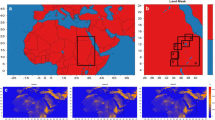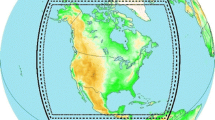Summary
A new regional atmospheric model was set up in a joint effort by DKRZ (Deutsches Klimarechenzentrum), DWD (Deutscher Wetterdienst), GKSS (Forschungszentrum Geesthacht) at the MPI (Max-Planck-Institut fuer Meteorologie). This model, called REMO (REgional MOdel) can be used in the weather forecast mode as well as in the climate mode. It is based on the Europa-Model (EM), the main weather forecast model of the new numerical weather prediction system of the Deutscher Wetterdienst. In addition to the physical parameterizations implemented in the EM, REMO has the possibility of using the same physics as the global climate model (MPI) into which it is nested to assess the scale dependence of physical parameterizations within the same dynamical framework.
This paper gives an overview over different case studies investigating the dependence of model results on simulation domain size, horizontal resolution, initial conditions and lateral boundaries especially for long term calculations. A sample of one month long integrations for an arbitrary July month, a four year long run for the Baltic Sea and its drainage basin and two summer seasons of the Indian Monsoon will be used to demonstrate the sensitivity of regional climate model results to different environments.
The sensitivity studies show that it is very important to use realistic large scale driving fields at the lateral boundaries. The regional model results are strongly influenced by the driving fields. The domain size and the simulation length are also influencing the results.
Similar content being viewed by others
References
Alestalo, M., 1981: The energy budget of the earthatmosphere system in Europe.Tellus,33, 360–371.
Bergstroem, S., Carlsson, B., 1993: Hydrology of the Baltic Basin. Inflow of fresh water from rivers and land for the period 1950–1990.SMHI Reports Hydrology,7, 32pp.
Creß, A., Majewski, D., Podzun, R., Renner, v., 1995: Simulation of European climate with a limited area model. Part I: Observed boundary conditions.Beitr. Phys. Atmosph.,68, 161–178.
Davies, H. C., 1976: A lateral boundary formulation for multi-level prediction models.Quart. J. Roy Meteor. Soc.,102, 405–418.
DKRZ, 1994: The ECHAM3 atmospheric general circulation model. Tech. Rep.6.
Jacobsen, I., Heise, E., 1982: A new economic method for the computation of the surface temperature in numerical models.Beitr. Phys. Atmos.,55, 128–141.
Jones, R. G., Murphy, J. M., Noguer, M., 1995: Simulation of Relimate change over Europe using a nested regional-climate model, I: Assessment of control climate, cicluding sensivity to location of lateral boundaries.Quart. J. Roy. Meteor. Soc.,121, 1413–1449.
Legates, D. R., Willmott, C. J., 1990: Mean seasonal and spatial variability in gauge-corrected precipitation.Int. J. Climatol.,10, 111–127.
Louis, J. F., 1979: A parametric model of vertical eddy fluxes in the atmosphere.Bound.—Layer Meteorol.,17, 187–202.
Machenhauer, B., Windelband, M., Botzet, M., Jones, R. G., Déqué M., 1996: Validation of present-day regional climate simulations over Europe: Nested LAM and variable resolution Global Model simulations with observed or mixed layer ocean boundary conditions. Max-Planck Institut f. Meteorologie, Hamburg, Report No. 191.
Majewski, D., 1991: The Europa-Modell of the Deutscher Wetterdienst.Seminar Proceedings ECMWF,2, 147–191
Mellor, G. L. Yamada, T., 1974: A hierachy of turbulence closure models for planetary boundary layers.J. Atmos. Sci.,31, 1791–1806.
Podzun, R., Creß, A., Majewski, D., Renner, V., 1995: Simulation of European climate with a limited area model. Part II: AGCM boundary conditionsBeitr. Phys. Atmosph.,68, 205–225.
Ritter, B., Geleyn, J. F. 1992: A comprehensive radiation scheme for numerical weather prediction models with potential applications in climate simulations.Mon. Wea. Rev.,120, 303–325.
Rockel, B., Raschke, E., Weyres, B., 1991: A parameterization of broad band radiative transfer properties of water, ice and mixed clouds.Beitr. Phys. Atmosph.,64, 1–12
Simmons, A. J., Burridge, D. M., 1981: An energy and angular-momentum conserving vertical finite-difference scheme and hybrid vertical coordinates.Mon. Wea. Rev.,109, 758–766.
Sjoeberg, B. (ed.), 1992:Sea and Coast. National Atlas of Sweden. Stockholm: Almqvist & Wiksell International.
Tiedke, M., 1989: A comprehensive mass flux scheme for cumulus parameterization in large-scale models.Mon. Wea. Rev.,117, 1779–1800.
Author information
Authors and Affiliations
Additional information
With 12 Figures
Rights and permissions
About this article
Cite this article
Jacob, D., Podzun, R. Sensitivity studies with the regional climate model REMO. Meteorl. Atmos. Phys. 63, 119–129 (1997). https://doi.org/10.1007/BF01025368
Received:
Revised:
Issue Date:
DOI: https://doi.org/10.1007/BF01025368




